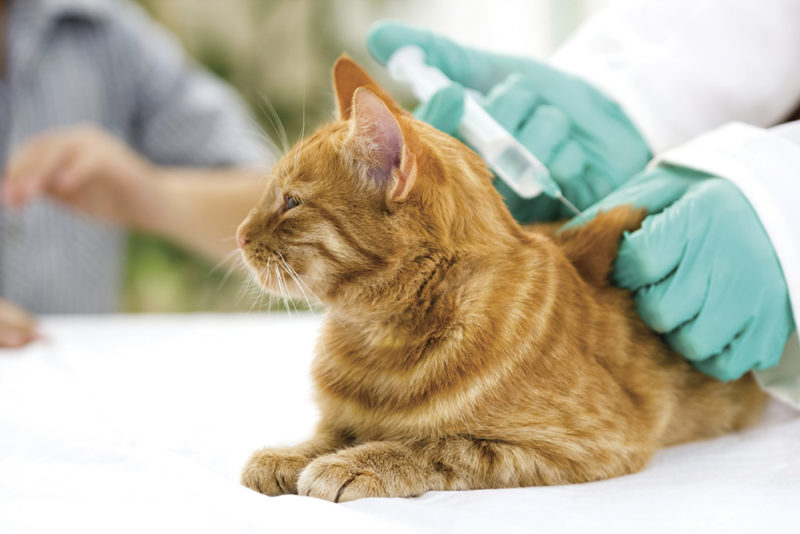 Vaccines are health products that trigger protective immune responses in pets and prepare them to fight future infections from disease-causing agents. Vaccines can lessen the severity of future diseases and certain vaccines can prevent infection altogether. Today, a variety of vaccines are available for use by veterinarians. Pets should be vaccinated to protect them from many highly contagious and deadly diseases. Experts agree that widespread use of vaccines within the last century has prevented death and disease in millions of dogs, cats, and other animals. Even though some formerly common diseases have now become uncommon, vaccination is still highly recommended because these serious disease agents continue to be present in the environment.
Vaccines are health products that trigger protective immune responses in pets and prepare them to fight future infections from disease-causing agents. Vaccines can lessen the severity of future diseases and certain vaccines can prevent infection altogether. Today, a variety of vaccines are available for use by veterinarians. Pets should be vaccinated to protect them from many highly contagious and deadly diseases. Experts agree that widespread use of vaccines within the last century has prevented death and disease in millions of dogs, cats, and other animals. Even though some formerly common diseases have now become uncommon, vaccination is still highly recommended because these serious disease agents continue to be present in the environment.
Canine Vaccination Guidelines -- Canine Core Vaccines
Core vaccines are recommended for all puppies and dogs with an unknown vaccination history. The diseases involved have significant morbidity and mortality and are widely distributed, and in general, vaccination results in relatively good protection from disease. These include vaccines for canine parvovirus (CPV), canine distemper virus (CDV), canine adenovirus (CAV), and rabies. In addition, the leptospirosis vaccine is now recommended as a core vaccine for dogs beVcause the disease has the potential to occur in any dog (even in urban environments), can be life-threatening, and the vaccines are considered safe and efficacious, with recent improvements in safety over the last decade.
Canine Parvovirus, Distemper Virus, and Adenovirus-2 Vaccines
For initial puppy vaccination, we recommend repeat vaccinations on a regular schedule. Maternal antibodies are transferred through blood products that contain antibodies to the fetus through the placenta, and it can also be induced artificially, when high levels of antibodies specific to a pathogen are transferred to non-immune persons through blood. For dogs older than 16 weeks of age, two doses of vaccine containing modified live virus (MLV) CPV, CDV, and CAV-2 given 3-4 weeks apart are recommended. After a booster at 6 months to one year, revaccination is recommended every 2 years thereafter, ideally using a product approved for 2-year administration, unless there are special circumstances that warrant more or less frequent revaccination. Note that recommendations for killed parvovirus vaccines and recombinant CDV vaccines are different from the above. We do not recommend vaccination with CAV-1 vaccines, since vaccination with CAV-2 results in immunity to CAV-1, and the use of CAV-2 vaccines results in less frequent adverse events.
Canine Distemper-Measles Combination Vaccine
This vaccine has been used between 8 and 20 weeks of age to protect dogs against distemper in the face of maternal antibodies directed at CDV. Protection occurs within 72 hours of vaccination. It is indicated only for use in households/kennels/shelters where CDV is a recognized problem. Only one dose of the vaccine should be given, after which pups are boostered with the CDV vaccine to minimize the transfer of anti-measles virus maternal antibodies to pups of the next generation.
Canine Borrelia burgdorferi (Lyme) Vaccine
The incidence of Lyme disease can happen near Northern Indiana & Wisconsin, not so much in Chicago. Furthermore, use of the vaccine even in endemic areas (such as the east coast of the US) has been controversial because of anecdotal reports of vaccine-associated adverse events. Most infected dogs show no clinical signs, and the majority of dogs contracting Lyme disease respond to treatment with antimicrobials. Furthermore, prophylaxis may be effectively achieved by preventing exposure to the tick vector. If travel to endemic areas (ie the east coast) is anticipated, vaccination could be considered, followed by boosters at intervals in line with risk of exposure. As global warming increases the range of different diseases will spread to new areas and in the future, we will see more diseases emerge.
Canine Rabies Virus Vaccines
We recommend that puppies receive a single dose of killed rabies vaccine at 16 weeks or 4 months of age. Adult dogs with unknown vaccination history should also receive a single dose of killed rabies vaccine. A booster is required one year later, and thereafter, rabies vaccination should be performed every 3 years using a vaccine approved for 3-year administration.
Canine Leptospira Vaccines
Multiple leptospira serovars are capable of causing disease in dogs, and minimal cross-protection is induced by each serovar. Currently available vaccines do not contain all serovars, and duration of immunity is probably about 1 year. However, leptospirosis is not uncommon in Chicago dogs both from urban backyards. In addition, the disease can be fatal or have high morbidity, and also has zoonotic potential. Therefore, we suggest annual vaccination of all dogs with vaccines containing all four Leptospira serovars (Grippotyphosa, Pomona, Canicola and Icterohaemorrhagiae). The initial vaccination should be followed by a booster 2-4 weeks later, and the first vaccine be given no earlier than 12 weeks of age. In general, Leptospira vaccines have been associated with more severe postvaccinal reactions (acute anaphylaxis) than other vaccines. The recent introduction of vaccines with reduced amounts of foreign protein has reduced this problem. Reaction rates for vaccines containing Leptospira, while higher than those for vaccines that do not contain Leptospira, are still low in incidence (in one study, < 0.6% @ VMTH). Vaccination of dogs that have had previous reactions to Leptospira vaccines should be avoided if possible. We do not recommend administering different vaccine antigens at separate time points because it reduces the chance that vaccines will be administered and there is poor evidence that it decreases the risk of reactions occurring.
Canine Non-Core Vaccines
Non-core vaccines are optional vaccines that should be considered in light of the exposure risk of the animal, ie. based on geographic distribution and the lifestyle of the pet. Several of the diseases involved are often self-limiting or respond readily to treatment. Vaccines considered as non-core vaccines are canine parainfluenza virus (CPiV), canine influenza virus H3N8, canine influenza virus H3N2 distemper-measles combination vaccine, Bordetella bronchiseptica, and Borrelia burgdorferi. Vaccination with these vaccines is generally less effective in protecting against disease than vaccination with the core vaccines.
Canine Parainfluenza Virus & Bordetella Bronchiseptica
These are both agents associated with 'kennel cough' or canine infectious respiratory disease complex (CIRDC) in dogs. For Bordetella bronchiseptica, mucosal vaccination with live avirulent bacteria is recommended for dogs expected to board, be shown, or to enter a kennel situation within a few months of the time of vaccination. For puppies, intense nasal botellar can be an issue, but we have the proper medication and treatments to help your puppy. We currently stock the intranasal vaccine containing both B. bronchiseptica and CPiV. For puppies and previously unvaccinated dogs, only one dose of this vaccine is required (recommendations differ for the parenteral, killed form of this vaccine). Most boarding kennels require that this vaccine be given prior to boarding; the vaccine should be administered at least one week prior to the anticipated boarding date for maximum effect. Although some kennels require immunization every 6 months, annual booster vaccination with B. bronchiseptica vaccines is considered adequate for protection.
Canine Influenza Virus (CIV)
Canine influenza virus H3N8 emerged in the United States in greyhounds in Florida in 2003. The virus is now enzootic in many dog populations in Colorado, Florida, Pennsylvania, New Jersey and New York. The virus causes upper respiratory signs including a cough, nasal discharge, and a low-grade fever followed by recovery. A small percentage of dogs develop more severe signs in association with hemorrhagic pneumonia. Canine influenza virus H3N2 emerged in 2015 in Illinois and has spread to several other states. Disease caused by CIV H3N2 may be slightly more severe than that caused by CIV H3N8, and the virus has affected more dogs in veterinary hospitals and the community (H3N8 has largely remained confined to shelters). Vaccines for both infections are commercially available. Use of the H3N2 vaccine may be warranted for dogs that contact other dogs, such as those that board. Vaccines may reduce clinical signs and virus shedding in dogs infected by CIV. Vaccination may have the potential to interfere with the results of serological testing, which in non-endemic areas are useful to assist diagnosis.

Allow 24 hours for change of appointment. Discounts are given if no appointments are missed in two consecutive years.
